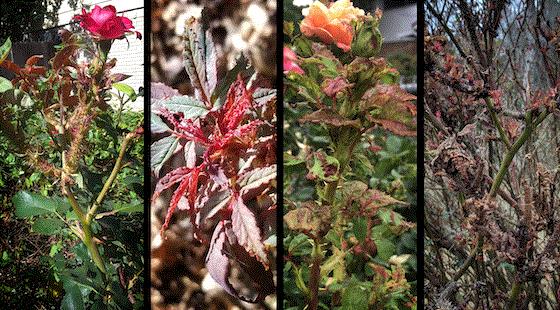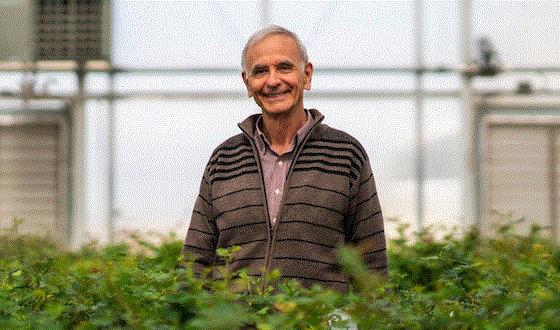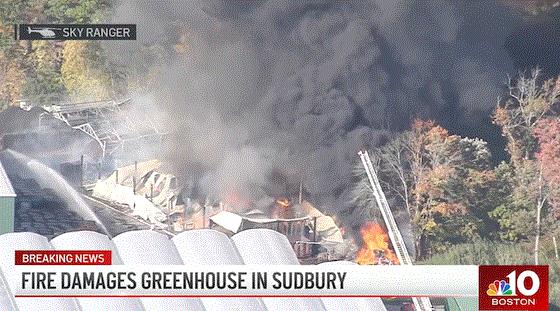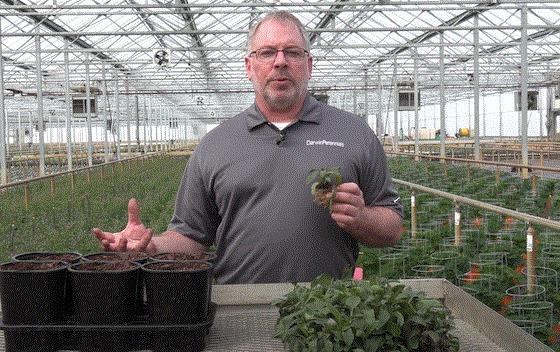Rose rosette about to get some serious research
One of the more devastating diseases of ornamental plants, rose rosette disease, is now the subject of a nationwide team of researchers, thanks to $4 million in funding from the U.S. Department of Agriculture Specialty Crop Research Initiative.
The project, “Developing Sustainable Rose Landscapes via Rose Rosette Disease Education, Socioeconomic Assessments, and Breeding RRD-Resistant Roses with Stable Black Spot Resistance,” is being led by David Byrne, Ph.D., the Basye Chair in Rose Genetics, and Oscar Riera-Lizarazu, Ph.D. Both are Texas A&M AgriLife Research rose geneticists in the Texas A&M Department of Horticultural Sciences in the College of Agriculture and Life Sciences. Dr. Byrne has been working on getting the project funded since 2019.
Rose rosette disease attacks roses (obviously), causing them to grow strangely deformed stems, leaves and flowers. It’s a virus that’s vectored by eriophyid mites. The disease leads to excessive thorn production, leaf distortion and excessive stem development, known as witches’ broom, at the ends of branches.
 Roses showing symptoms of rose rosette disease. Photos from Texas A&M AgriLife.
Roses showing symptoms of rose rosette disease. Photos from Texas A&M AgriLife.
Most cultivated rose varieties are susceptible to both diseases. It's devastated existing plantings and impacted landscape use. According to the Census of Horticulture Specialties, the landscape rose market has decreased by about 10% each year. Approximately 35% of garden roses sold are used by the professional landscape market.
The project’s long-term goal is to develop sustainable landscapes based on cultivars resistant to rose rosette and black spot diseases. To do this, they’ve assembled a multi-state team of 21 researchers from Texas A&M; the University of Minnesota; the University of Tennessee; USDA-Agricultural Research Service in Beltsville, Maryland; the University of Tulsa; Oklahoma State University; the University of Georgia at Athens and Tifton; The Ohio State University; and the University of Wisconsin-River Falls.

The researchers will be combining traditional plant breeding with molecular genotyping to double the speed of the breeding selection process, Dr. Byrne says.They’ll be collaborating with industry partners and hundreds of “citizen scientists,” plus extension programs in Texas, Georgia, Tennessee and Ohio, who will monitor rose rosette’s geographic distribution. They’ll use multi-state trials to determine the best practices for managing the diseases, including chemical and cultural control methods, as well as disease-resistant germplasm.
To disseminate their findings, they’ve put together a network of private and public stakeholders, including breeding programs, production and wholesale/retail nurseries, landscapers, consumers, rose enthusiasts, public gardens, major rose testing organizations and industry publishers (including GrowerTalks).
“We believe this widespread education will lead to better management and lower costs for the industry and longer-lived plants that deliver enhanced enjoyment and consumer satisfaction,” Dr. Byrne says.
The ultimate goal is the restoration of healthy rose collections to botanical gardens, public parks and private landscapes.

Fire at Cavicchio Greenhouses
Thankfully, nobody was hurt and no greenhouses were lost, but Sudbury, Massachusetts-based Cavicchio Greenhouses suffered a big storage building fire Wednesday afternoon, October 12. The three-alarm fire engulfed a 60 by 100-ft. storage building said to contain equipment and fertilizers. Because of the presence of the latter, firefighters and a hazmat team were monitoring air conditions after the fire.
Approximately 70 firefighters from around the region responded.

Thursday, on my behalf, Jen Zurko reached out to Kerri Stafford, whom we had visited with back in August. Kerri sent back a quick text stating, “It was a storage facility that burned and no one was hurt. We are in clean-up mode today.”
This isn’t Cavicchio’s first fire. Back in 2010 we filed THIS report on a major fire that took out about 30% of their greenhouse space, causing $5 million in damage. And that was in May, during peak season.
Thoughts on greenhouse heating
This Thursday, I’m giving the keynote at the Kansas Greenhouse Growers Association meeting. The topic? “Acres Online Live,” in which I do this … only live on a stage, talking, instead of slouched in my office chair, typing.
One of the topics I plan on covering is the coming heating season. Last year, some folks in the Midwest and Plains states got caught up in Winter Storm Uri and the resulting natural gas shortages, and they saw heating bills rise astronomically—in one case, from $3K in February 2020 to $92K in February 2021. The only good news about Uri? They say it was a once-in-30-year storm, which means you’ve got 29 years to get your heating fuel locked in!
As for prices: In September, the Henry Hub spot price averaged $7.88 per dekatherm (MMBtu). That’s down from $8.81 in August, but up from $7.28 in July. A year ago it was in the $5.50 range. Two years ago—2020—it bounced between just $2 and $3! Ah, the good old days!
The U.S. Energy Information Administration expects the Henry Hub price to average about $9/MMBtu in 4Q22 and then fall to an average of about $6/MMBtu next year as U.S. natural gas production rises.
(Gas production rises? Do they know something we don’t know?)
Anyway, it sounds like $9 to $10 is the going rate this winter—which stinks, but it could be 10 times that like last year.

Bill Swanekamp’s fuel-buying advice
Anyway, I can’t prevent rising prices or winter storms, but I can seek expert advise on how to weather such occurences. And for that I looked to my heating-fuel-purchasing genius Bill Swanekamp of Kube-Pak wholesale greenhouse in New Jersey and author of the “Managing Your Business” chapter in the most recent Ball RedBook. Here are his answers to three questions:
Chris: What do your energy experts say about the overall outlook—if that’s even a question that can be guessed at?
Bill: A very difficult question to answer. Overall, it seems world events are lining up to create a very difficult energy environment. The biggest variable is the war in Ukraine. It could get a lot worse and the world will be plunged into a severe energy crisis. Prices will skyrocket to the levels we saw in 2007-08. OPEC just added fuel to the fire by cutting oil production and raising the prices for America. Definitely a form of retaliation for the U.S. stand on human rights abuses.
The U.S. has tremendous energy production capability, but it cannot supply the world market. We can certainly supply our domestic needs, but foreign policy will prevent that kind of protectionism. If the war in Ukraine is resolved peacefully and Russian natural gas starts to flow again, things will go back to normal pretty quickly.
This situation only reinforces the need for alternative sources of energy that can be domestically produced. Forget the politics and invest in renewable energy.
Chris: For someone who doesn’t already have their natural gas locked in at a favorable price, what should they be doing?
Bill: Be prepared to take out a second mortgage!!!! Seriously, keep a close eye on the daily ups and downs of the futures market. You may be able to lock in at $9 or $10/dekatherm, and if that opportunity comes, take it! Remember, “pigs get fat and hogs get slaughtered” (meaning don’t get greedy and try to hold out for a cheaper price).
The other option would be to start you crops later and shorten your heating season, then be prepared to fill your greenhouse quickly about four weeks before Mother’s Day. You can only hope the season is late and the delay will not hurt your sales too badly.
Chris: What is the best long-term strategy for a grower to avoid losing sleep over their winter heating costs?
Bill: If you want to stay in the greenhouse business long-term, educate yourself about how to purchase energy on the futures market and lock in for two to three years. This helps smooth out the highs and lows, and gives you a stable heating fuel price when setting your prices.
Thanks, Bill! Let’s hope for a mild winter and an early spring!

It’s Wage & Benefit Survey Time
Every year we ask you, our faithful readers, to fill out our survey on the wages you pay and the kind of benefits you offer. We then aggregate the answers and run the results in the December issue of GrowerTalks and the January issue of Green Profit. Why? Because it helps everyone in the industry, employers and employees alike, to see wage and benefit breakdowns by region and operation size.

If you have both a growing operation and a retail operation, we ask that you fill both out. You have until October 28 to fill out the survey, but don’t delay! As a bonus, if you include your email address with your answer, you’ll be entered into a drawing to win a way-cool (literally) Yeti Tundra 45 Hard Cooler (a $325 value).
For growers, find the survey HERE.
For retailers, find the survey HERE.
Thanks in advance for your help in providing this valuable service to the industry. And special thanks to our sponsor, Florasearch, Inc., for all their support.
Webinar: Overwintering perennials
I’ve never grown perennials (I was in Florida where everything is a perennial), but I do know that “How do I overwinter this?” has got to be one of the top three perennial questions growers ask.
That’s why we’re hosting the webinar, “3½ Steps to Overwintering Perennials.” It's slated for Thursday, October 27, at 1:00 p.m. Eastern/Noon Central.
Our expert is none other than Chris Fifo, Darwin Perennials’ perennial product rep and former grower for Swift Greenhouses. Chris will dig into his 30 years of growing experience to help you achieve overwintering production success.

In this webinar, you’ll learn how to choose the right varieties for you, how to choose the right structure, and you’ll learn all about culture and growing techniques to get you and your crops to the other side of winter.
Why 3.5 steps instead of 3 or 4? If you’re as curious as me, you’ll tune into the webinar on Thursday, October 27 to find out.
Register for the webinar at www.growertalks.com/webinars.
As usual, this session, sponsored by the folks at Darwin Perennials, will be moderated by your’s truly, so you know it will be fast-paced, informative and fun!

Average retail sales follow-up
I caught the attention of two Brits a few weeks ago when I wrote about average retail sales data released by the International Garden Center Association at their recent annual Congress in Amsterdam in September. The data revealed that U.S. consumers have the highest average sale per visit—$90.
For some reason, the IGCA data didn’t include the UK, but Eve Tigwell, a UK garden “centre” consultant (whose office address is Hawthorne Cottage, 2 Friggle Street, near Frome), was able to oblige me. She wrote:
“That’s a great average sale per customer for the U.S.! Like you, I’d start thinking about how often customers visit garden centres and their average total sale per year. The UK’s HTA (Horticulture Trade Association) sends out monthly updates of various figures, so I checked their latest: the average sale in August 2022 was £25.97, back in May it was £34.01, so maybe not too far behind Ireland. You can take these figures as comparable to U.S. $, since our currency has just dropped a bit.”
I’m surprised the UK number is as low as it is, but in my original piece I speculated that U.S. customers shop, on average, only a few times a year at a garden center, so they probably load up. In the UK, they may visit monthly or even more often, perhaps to enjoy the café, and so spend less per visit, but spend more per year. It wouldn't surprise me at all if that’s the case.
Another consultant, Ian Baldwin, a Brit-turned-American (21 years ago), didn’t share UK data, he shared additional U.S. data—from The 5 Number Project, which he does with Dr. Charlie Hall as part of Charlie’s “Your Market Metrics” project. Wrote Ian:
“Our 60 IGC companies (65 stores, doing a total of over $400 million in retail) who report monthly performance data through The 5 Number Project, have the following average sales metrics:
- 2022 Avg. sale YTD through August = $88.59
- 2021 Avg. sale YTD through August = $81.11
- 2019 Avg. sale YTD through August = $70.43
(For reference, the aggregate Avg. Sale at YE, December 31, 2021 was $84.05.)
“You can see the huge growth in the last three years (hopefully not fueled entirely by price inflation.)
“You are correct that garden center shoppers across the pond shop much more frequently in a year. Our general rule over the years has been that the UK Avg. Sale runs less than half of the U.S. equivalent. Gardens are smaller and unit prices lower over there, but mostly it’s all those cakes and cups of tea that bring it down compared with the U.S.”
Thanks very much, Eve and Ian, for sharing what you know!

More H-2B work visas coming in 2023
Finally, a little bit of labor relief—at least for those who take advantage of the H-2B Visa program, which would primarily be landscapers: The news was released this week by the U.S. Department of Homeland Security (DHS) and Department of Labor (DOL) that they'll be issuing a regulation to make available to employers an additional 64,716 H-2B temporary non-agricultural work visas for the fiscal year 2023. This nearly doubles the 66,000 H-2B visas normally available, providing much needed labor relief and the opportunity for better business planning in the coming year.
AmericanHort’s Craig Regelbrugge, Executive Vice President of Advocacy, Research, and Industry Relations, said, “We are pleased with this announcement due to the much-needed relief it provides to our landscaping industry to find additional workers they desperately need to operate. We look forward to continuing to work hard with the H-2B Workforce Coalition to urge Congress to address the outdated H-2B visa cap and pursue long-term relief.”
The visas don’t come without fine print: 20,000 of them are reserved for nationals of Haiti and the Northern Central American countries. Reserving visas for nationals of Haiti and Northern Central American countries of Honduras, Guatemala, and El Salvador advances the Biden Administration’s pledge to address irregular migration from those countries.
The remaining 44,716 supplemental visas will be available to returning workers who received an H-2B visa, or were otherwise granted H-2B status, during one of the last three fiscal years.
DHS and DOL also announced the creation of the H-2B Worker Protection Taskforce, which will consider a variety of policy options to address threats to the integrity of the program and will provide an opportunity for relevant stakeholders to offer input.

Finally …

When it comes to spreading the word about invasive pests, who knew Saturday Night Live would be an ally? But they are when it comes to the spotted lanternfly … which is not only invasive, but has a really bad attitude, too.
Feel free to email me at beytes@growertalks.com if you have ideas, comments or questions.
See you next time!

Chris Beytes
Editor
GrowerTalks and Green Profit
This e-mail received by 25,811 loyal readers!
Thanks to my loyal sponsors, who help me reach the 25,811 readers of Acres Online in more than 60 countries. Want to be one of them (a sponsor, that is)? Give Kim Brown a shout and she will tell you about our many advertising opportunities.